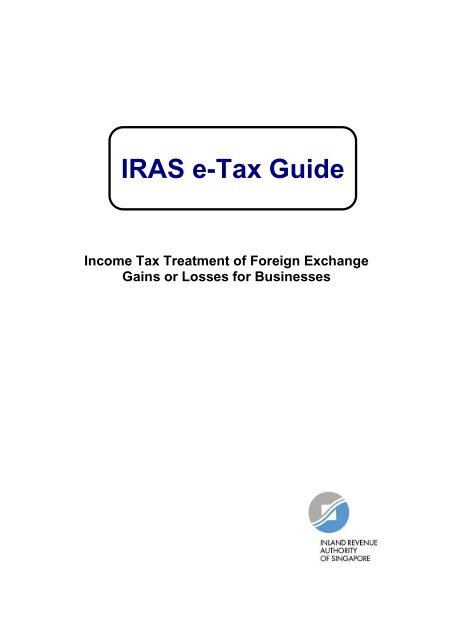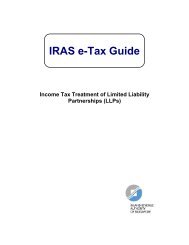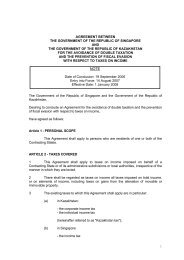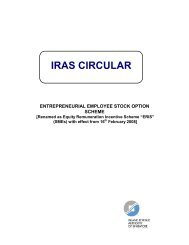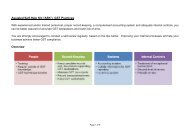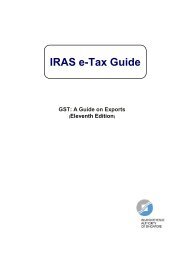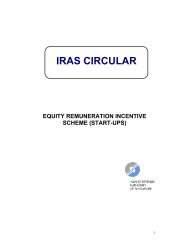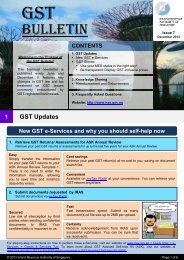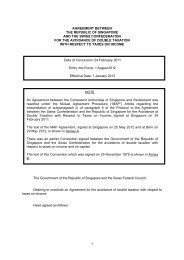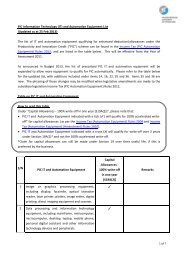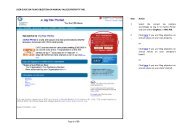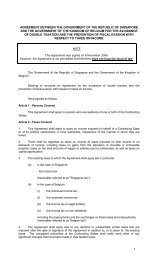Income Tax Treatment of Foreign Exchange Gains or Losses ... - IRAS
Income Tax Treatment of Foreign Exchange Gains or Losses ... - IRAS
Income Tax Treatment of Foreign Exchange Gains or Losses ... - IRAS
Create successful ePaper yourself
Turn your PDF publications into a flip-book with our unique Google optimized e-Paper software.
<strong>IRAS</strong> e-<strong>Tax</strong> Guide<br />
<strong>Income</strong> <strong>Tax</strong> <strong>Treatment</strong> <strong>of</strong> <strong>F<strong>or</strong>eign</strong> <strong>Exchange</strong><br />
<strong>Gains</strong> <strong>or</strong> <strong>Losses</strong> f<strong>or</strong> Businesses
Published by<br />
Inland Revenue Auth<strong>or</strong>ity <strong>of</strong> Singap<strong>or</strong>e<br />
Published on 29 Jun 2012<br />
© Inland Revenue Auth<strong>or</strong>ity <strong>of</strong> Singap<strong>or</strong>e<br />
All rights reserved. No part <strong>of</strong> this publication may be<br />
reproduced <strong>or</strong> transmitted in any f<strong>or</strong>m <strong>or</strong> by any<br />
means, including photocopying and rec<strong>or</strong>ding without<br />
the written permission <strong>of</strong> the copyright holder,<br />
application f<strong>or</strong> which should be addressed to the<br />
publisher. Such written permission must also be<br />
obtained bef<strong>or</strong>e any part <strong>of</strong> this publication is st<strong>or</strong>ed<br />
in a retrieval system <strong>of</strong> any nature.<br />
1
Table <strong>of</strong> Contents<br />
Page<br />
1 Aim ............................................................................................................ 3<br />
2 At a glance ............................................................................................... 3<br />
3 Glossary ................................................................................................... 5<br />
4 <strong>Tax</strong> treatment <strong>of</strong> f<strong>or</strong>eign exchange differences .................................... 6<br />
5 Accounting versus tax treatment ........................................................... 7<br />
6 Administrative concession – To accept accounting treatment f<strong>or</strong><br />
revenue f<strong>or</strong>eign exchange differences .................................................. 8<br />
7 Administrative concession – To regard the designated bank account<br />
maintained f<strong>or</strong> receiving trade receipts and paying revenue<br />
expenses as revenue in nature .............................................................. 9<br />
8 Contact inf<strong>or</strong>mation .............................................................................. 10<br />
9 Updates and amendments .................................................................... 11<br />
Annex – Example to illustrate the accounting and tax treatments <strong>of</strong><br />
f<strong>or</strong>eign exchange differences arising from f<strong>or</strong>eign currencies<br />
transactions ................................................................................... 12<br />
2
<strong>Income</strong> <strong>Tax</strong> <strong>Treatment</strong> <strong>of</strong> <strong>F<strong>or</strong>eign</strong> <strong>Exchange</strong> <strong>Gains</strong> <strong>or</strong> <strong>Losses</strong><br />
f<strong>or</strong> Businesses<br />
1 Aim<br />
1.1 This e-<strong>Tax</strong> Guide provides details on the tax treatment <strong>of</strong> f<strong>or</strong>eign<br />
exchange gains <strong>or</strong> losses f<strong>or</strong> businesses (banks and businesses<br />
other than banks). This e-<strong>Tax</strong> Guide consolidates the two e-<strong>Tax</strong><br />
guides issued previously on the income tax treatment <strong>of</strong> f<strong>or</strong>eign<br />
exchange gains <strong>or</strong> losses 1 .<br />
1.2 It would be relevant to businesses which have f<strong>or</strong>eign exchange gains<br />
<strong>or</strong> losses.<br />
2 At a glance<br />
2.1 The tax treatment <strong>of</strong> f<strong>or</strong>eign exchange differences is summarised in<br />
the table as follows:<br />
Description <strong>F<strong>or</strong>eign</strong> exchange<br />
differences arising<br />
from revenue<br />
transactions<br />
Nature <strong>of</strong> f<strong>or</strong>eign exchange differences<br />
Revenue Capital Translation<br />
<strong>F<strong>or</strong>eign</strong> exchange<br />
differences arising<br />
from capital<br />
transactions<br />
Whether a transaction is capital <strong>or</strong><br />
revenue in nature depends on the facts<br />
and circumstances <strong>of</strong> each case<br />
<strong>F<strong>or</strong>eign</strong> exchange<br />
differences arising<br />
from translating<br />
financial<br />
statements<br />
prepared in the<br />
functional currency<br />
<strong>of</strong> the business to<br />
another currency<br />
f<strong>or</strong> presentation<br />
purposes<br />
<strong>Tax</strong><br />
treatment<br />
All exchange<br />
differences<br />
recognised in the<br />
pr<strong>of</strong>it and loss<br />
account are<br />
taxable <strong>or</strong><br />
deductible even if<br />
there is no<br />
physical<br />
conversion <strong>of</strong> the<br />
f<strong>or</strong>eign currencies<br />
Not taxable <strong>or</strong><br />
deductible<br />
Not taxable <strong>or</strong><br />
deductible<br />
1<br />
This e-<strong>Tax</strong> Guide is a consolidation <strong>of</strong> two previous e-<strong>Tax</strong> guides on:<br />
a. “<strong>Treatment</strong> <strong>of</strong> f<strong>or</strong>eign exchange gains <strong>or</strong> losses f<strong>or</strong> banks” published on 2 Nov 1993; and<br />
b. “<strong>Income</strong> <strong>Tax</strong> <strong>Treatment</strong> <strong>of</strong> <strong>F<strong>or</strong>eign</strong> <strong>Exchange</strong> <strong>Gains</strong> <strong>or</strong> <strong>Losses</strong> f<strong>or</strong> Businesses” published on 28<br />
Nov 2003.<br />
3
Nature <strong>of</strong> f<strong>or</strong>eign exchange differences<br />
Revenue Capital Translation<br />
Condition<br />
f<strong>or</strong> tax<br />
treatment<br />
The accounting<br />
treatment is<br />
consistently<br />
applied to both the<br />
f<strong>or</strong>eign exchange<br />
gains and losses<br />
Not applicable<br />
Not applicable<br />
Effective<br />
date <strong>of</strong> tax<br />
treatment<br />
Banks<br />
Granted<br />
automatically since<br />
2 Nov 1993<br />
Not applicable<br />
Not applicable<br />
Non-banks<br />
Granted<br />
automatically since<br />
the Year <strong>of</strong><br />
Assessment 2004<br />
unless opted-out<br />
2.2 Please refer to the paragraphs below f<strong>or</strong> further details.<br />
4
3 Glossary<br />
3.1 Capital f<strong>or</strong>eign exchange differences<br />
These are f<strong>or</strong>eign exchange differences arising from capital<br />
transactions. The f<strong>or</strong>eign exchange differences are capital in nature.<br />
3.2 <strong>F<strong>or</strong>eign</strong> exchange differences<br />
<strong>F<strong>or</strong>eign</strong> exchange gains <strong>or</strong> losses are collectively referred to as<br />
f<strong>or</strong>eign exchange differences.<br />
3.3 Functional currency<br />
Functional currency is the currency <strong>of</strong> the primary economic<br />
environment in which the entity operates. Another term f<strong>or</strong> functional<br />
currency is measurement currency.<br />
3.4 Revenue f<strong>or</strong>eign exchange differences<br />
These are f<strong>or</strong>eign exchange differences arising from revenue<br />
transactions. The f<strong>or</strong>eign exchange differences are revenue in<br />
nature.<br />
3.5 Translation<br />
Translation refers to the conversion <strong>of</strong> an amount in f<strong>or</strong>eign currency<br />
to a business’ functional currency.<br />
3.6 Translation f<strong>or</strong>eign exchange differences<br />
These are f<strong>or</strong>eign exchange differences arising from translating the<br />
financial statements prepared in the functional currency <strong>of</strong> the<br />
business to another currency f<strong>or</strong> presentation purpose.<br />
5
4 <strong>Tax</strong> treatment <strong>of</strong> f<strong>or</strong>eign exchange differences<br />
4.1 <strong>F<strong>or</strong>eign</strong> exchange differences can arise from capital <strong>or</strong> revenue<br />
transactions. Whether a transaction is capital <strong>or</strong> revenue in nature is<br />
dependent on the facts and circumstances <strong>of</strong> each case.<br />
4.2 F<strong>or</strong> income tax purposes, f<strong>or</strong>eign exchange differences arising from<br />
capital transactions (“capital f<strong>or</strong>eign exchange differences”) are<br />
capital in nature. They are, theref<strong>or</strong>e, not taxable as income <strong>or</strong><br />
deductible as an expense (referred to as “taxable <strong>or</strong> deductible”). On<br />
the other hand, f<strong>or</strong>eign exchange differences arising from revenue<br />
transactions (“revenue f<strong>or</strong>eign exchange differences”) are revenue in<br />
nature. They are, theref<strong>or</strong>e, taxable <strong>or</strong> deductible.<br />
4.3 It is a well established principle <strong>of</strong> taxation that gains <strong>or</strong> losses are<br />
recognised f<strong>or</strong> tax purposes only when they are realised. Thus,<br />
revenue f<strong>or</strong>eign exchange differences are taxable <strong>or</strong> deductible only<br />
when they are realised.<br />
4.4 <strong>F<strong>or</strong>eign</strong> exchange differences are considered as realised when the<br />
f<strong>or</strong>eign currencies are physically converted into <strong>or</strong> exchanged f<strong>or</strong> the<br />
functional currencies <strong>of</strong> the businesses, <strong>or</strong> vice versa.<br />
4.5 However, f<strong>or</strong> administrative ease, the Comptroller <strong>of</strong> <strong>Income</strong> <strong>Tax</strong><br />
(“CIT”) regards revenue f<strong>or</strong>eign exchange differences arising under<br />
these two situations as realised even if there is no physical<br />
conversion <strong>or</strong> exchange <strong>of</strong> the f<strong>or</strong>eign currencies:<br />
a. Sales/purchases settled in the same accounting period<br />
The sales <strong>or</strong> purchases <strong>of</strong> the business transacted in f<strong>or</strong>eign<br />
currencies (i.e. currencies other than the functional currency) are<br />
settled (i.e. payment received <strong>or</strong> made) in the same accounting<br />
period. However, the exchange rates at the time <strong>of</strong> the<br />
transactions and at the time <strong>of</strong> settlement <strong>of</strong> the transactions<br />
may be different. As a result, f<strong>or</strong>eign exchange differences are<br />
charged to the pr<strong>of</strong>it and loss account. F<strong>or</strong> administrative ease,<br />
they are regarded as realised when the transactions which give<br />
rise to them are settled. They are taxable <strong>or</strong> deductible in the<br />
same accounting year. Please refer to the example in the Annex.<br />
b. Sales/purchases not settled in the same accounting period<br />
The sales <strong>or</strong> purchases <strong>of</strong> the business transacted in f<strong>or</strong>eign<br />
currencies are not settled in the same accounting period in<br />
which the transactions arose. However, the exchange rates at<br />
the end <strong>of</strong> the accounting period may be different from those at<br />
the transaction date <strong>or</strong> that applied at the end <strong>of</strong> the previous<br />
accounting year-end. As a result, f<strong>or</strong>eign exchange differences<br />
arising from translating the monetary items (e.g. debt<strong>or</strong>s and<br />
credit<strong>or</strong>s) denominated in f<strong>or</strong>eign currencies into the functional<br />
6
currency <strong>of</strong> the business are charged to the pr<strong>of</strong>it and loss<br />
account. F<strong>or</strong> administrative ease, they are deemed to be<br />
realised in the following year and taxable <strong>or</strong> deductible<br />
acc<strong>or</strong>dingly. Please refer to the example in the Annex.<br />
4.6 Apart from f<strong>or</strong>eign exchange differences arising from capital <strong>or</strong><br />
revenue transactions, f<strong>or</strong>eign exchange differences may also arise<br />
from translating the financial statements prepared in the functional<br />
currency (e.g. US$) <strong>of</strong> the business to another currency (e.g. S$) f<strong>or</strong><br />
presentation purpose (“translation f<strong>or</strong>eign exchange differences”).<br />
These are merely notional gains <strong>or</strong> losses and are theref<strong>or</strong>e not<br />
taxable <strong>or</strong> deductible f<strong>or</strong> tax purposes.<br />
4.7 The table below summarises the tax treatment <strong>of</strong> f<strong>or</strong>eign exchange<br />
differences mentioned in the paragraphs above:<br />
Nature <strong>of</strong> f<strong>or</strong>eign<br />
exchange differences<br />
Realised <strong>or</strong><br />
unrealised?<br />
<strong>Tax</strong>able <strong>or</strong><br />
deductible?<br />
Capital Not relevant No<br />
Realised<br />
Yes<br />
Revenue<br />
Unrealised<br />
No, unless<br />
regarded as<br />
realised by CIT in<br />
paragraphs 4.5(a)<br />
and 4.5(b) above<br />
Translation Not relevant No<br />
5 Accounting versus tax treatment<br />
5.1 F<strong>or</strong> accounting purposes, the pr<strong>of</strong>it and loss account does not<br />
separately reflect capital, revenue <strong>or</strong> translation exchange differences<br />
and whether they are realised <strong>or</strong> unrealised.<br />
5.2 In view <strong>of</strong> the different treatment <strong>of</strong> f<strong>or</strong>eign exchange differences f<strong>or</strong><br />
tax purposes, businesses need to keep track <strong>of</strong> their f<strong>or</strong>eign currency<br />
transactions which are revenue in nature. This is so that they can<br />
determine if the f<strong>or</strong>eign currencies have been physically converted<br />
into the functional currencies bef<strong>or</strong>e treating the revenue f<strong>or</strong>eign<br />
exchange differences as realised f<strong>or</strong> income tax purposes.<br />
7
5.3 The CIT recognises that the tracking <strong>of</strong> the f<strong>or</strong>eign currency<br />
transactions requires additional eff<strong>or</strong>ts and f<strong>or</strong> some businesses, the<br />
transactions involved may be voluminous. Businesses have<br />
represented that they face difficulties in distinguishing between<br />
realised and unrealised revenue f<strong>or</strong>eign exchange differences.<br />
Taking into consideration the feedback from businesses on the tax<br />
treatment <strong>of</strong> f<strong>or</strong>eign exchange differences, the CIT has put in place<br />
two concessionary tax treatments f<strong>or</strong> revenue f<strong>or</strong>eign exchange<br />
differences.<br />
6 Administrative concession – To accept accounting treatment f<strong>or</strong><br />
revenue f<strong>or</strong>eign exchange differences<br />
6.1 The CIT accepts, f<strong>or</strong> tax purposes, the accounting treatment adopted<br />
by businesses f<strong>or</strong> revenue f<strong>or</strong>eign exchange differences. This means<br />
that businesses will no longer need to distinguish between realised<br />
and unrealised revenue f<strong>or</strong>eign exchange differences. All revenue<br />
f<strong>or</strong>eign exchange differences will be taxable <strong>or</strong> deductible in the year<br />
they are charged to the pr<strong>of</strong>it and loss account.<br />
6.2 Scope <strong>of</strong> the administrative concession<br />
The concession only applies:<br />
a. to revenue f<strong>or</strong>eign exchange differences. Capital and<br />
translation f<strong>or</strong>eign exchange differences remain not taxable <strong>or</strong><br />
deductible; and<br />
b. when the same accounting treatment is consistently applied to<br />
both revenue f<strong>or</strong>eign exchange gains and revenue f<strong>or</strong>eign<br />
exchange losses.<br />
6.3 Effective dates <strong>of</strong> the administrative concession<br />
a. Banks<br />
The concession applies to banks with effect from 2 Nov 1993.<br />
b. Businesses other than banks<br />
The concession applies automatically to all businesses other<br />
than banks with effect from the Year <strong>of</strong> Assessment 2004.<br />
If any businesses other than banks have opted out <strong>of</strong> the<br />
concession when submitting the income tax return f<strong>or</strong> the Year<br />
<strong>of</strong> Assessment 2004, their decision is irrevocable 2 . These<br />
businesses must follow the tax treatment <strong>of</strong> f<strong>or</strong>eign exchange<br />
2<br />
Businesses other than banks were given the option to opt out <strong>of</strong> the administrative concession when<br />
it was introduced in 2003 (“<strong>Income</strong> <strong>Tax</strong> <strong>Treatment</strong> <strong>of</strong> <strong>F<strong>or</strong>eign</strong> <strong>Exchange</strong> <strong>Gains</strong> <strong>or</strong> <strong>Losses</strong> f<strong>or</strong><br />
Businesses” published on 28 Nov 2003”).<br />
8
differences as explained in paragraph 4. This means that<br />
revenue f<strong>or</strong>eign exchange differences are not taxable <strong>or</strong><br />
deductible until they are realised <strong>or</strong> regarded as realised by CIT<br />
in paragraphs 4.5(a) and 4.5(b).<br />
6.4 In the first assessment year that the concession is effective, any pri<strong>or</strong><br />
years unrealised revenue exchange differences which were not<br />
taxable <strong>or</strong> deductible previously, would have been regarded as<br />
realised in that assessment year.<br />
7 Administrative concession – To regard the designated bank<br />
account maintained f<strong>or</strong> receiving trade receipts and paying<br />
revenue expenses as revenue in nature<br />
7.1 Some businesses maintain f<strong>or</strong>eign currency bank accounts f<strong>or</strong> the<br />
purposes <strong>of</strong> their business operations. <strong>F<strong>or</strong>eign</strong> exchange differences<br />
may arise when businesses translate the year-end balances <strong>of</strong> these<br />
accounts into their functional currency. From the tax perspective,<br />
such f<strong>or</strong>eign exchange differences are regarded as capital in nature<br />
and theref<strong>or</strong>e, not taxable <strong>or</strong> deductible. The reasons being:<br />
a. Generally, the funds in bank accounts constitute the capital<br />
assets <strong>of</strong> the businesses; and<br />
b. The bank accounts hold the cash proceeds <strong>of</strong> the businesses<br />
(e.g. sales <strong>or</strong> investments) and provide the means f<strong>or</strong> payment<br />
(e.g. purchases <strong>of</strong> stocks <strong>or</strong> assets). The f<strong>or</strong>eign exchange<br />
differences arising from any revenue transactions would have<br />
been recognised f<strong>or</strong> tax purposes when they are settled. Hence,<br />
the f<strong>or</strong>eign exchange differences arising from the translation <strong>of</strong><br />
the year-end balances <strong>of</strong> the f<strong>or</strong>eign currency bank accounts<br />
into the businesses’ functional currency represent the cost <strong>of</strong><br />
holding the f<strong>or</strong>eign currencies to meet both capital and revenue<br />
requirements <strong>of</strong> the businesses.<br />
7.2 Some businesses may, however, designate a specific f<strong>or</strong>eign<br />
currency bank account (“designated bank account”) solely f<strong>or</strong> the<br />
purpose <strong>of</strong> receiving trade receipts 3 and paying revenue expenses 4 in<br />
a particular f<strong>or</strong>eign currency. The designated bank account is not<br />
used f<strong>or</strong> any other purposes. In such a case, the CIT is prepared to<br />
regard the designated bank account as revenue in nature. Hence,<br />
any f<strong>or</strong>eign exchange differences arising from the translation <strong>of</strong> the<br />
year-end balance <strong>of</strong> the designated bank account into the businesses’<br />
functional currency will be taxable <strong>or</strong> deductible.<br />
3<br />
4<br />
Sales on revenue account, whether <strong>of</strong> goods <strong>or</strong> services, <strong>or</strong> trade debt<strong>or</strong>s are collectively known as<br />
trade receipts.<br />
Purchases on revenue account, whether goods <strong>or</strong> services, <strong>or</strong> trade credit<strong>or</strong>s <strong>or</strong> operating expenses<br />
are collectively known as revenue expenses.<br />
9
7.3 Effective date <strong>of</strong> the administrative concession<br />
The concession is effective from the Year <strong>of</strong> Assessment 2004.<br />
7.4 Administrative procedure<br />
Any business who wishes to enjoy the administrative concession<br />
under paragraph 7.2 would need to:<br />
a. inf<strong>or</strong>m the CIT in writing that it maintains a designated bank<br />
account as mentioned in paragraph 7.2; and<br />
b. provide documentary evidence to substantiate its claim in<br />
paragraph 7.4(a). An example <strong>of</strong> such documentary evidence is<br />
the bank statements <strong>of</strong> the designated bank account showing<br />
frequent movements in the funds that are due to trade receipts<br />
and payments f<strong>or</strong> revenue expenses.<br />
8 Contact inf<strong>or</strong>mation<br />
8.1 If you have any enquiries <strong>or</strong> need clarification on this Guide, please<br />
call 1800-3568622.<br />
10
9 Updates and amendments<br />
Date <strong>of</strong><br />
amendment<br />
Amendments made<br />
1 29 Jun 2012 Previously, once businesses other than banks have<br />
opted out <strong>of</strong> the administrative concession to apply<br />
the accounting treatment f<strong>or</strong> revenue f<strong>or</strong>eign<br />
exchange differences, the revenue f<strong>or</strong>eign exchange<br />
differences are only taxable <strong>or</strong> deductible f<strong>or</strong> income<br />
tax purposes when they are realised*.<br />
The CIT is prepared to accept the revenue f<strong>or</strong>eign<br />
exchange differences as taxable <strong>or</strong> deductible f<strong>or</strong><br />
income tax purposes when they are realised <strong>or</strong><br />
regarded as realised by the CIT (refer to paragraph<br />
6.3(b)).<br />
* Paragraph 12 <strong>of</strong> the e-<strong>Tax</strong> guide, <strong>Income</strong> <strong>Tax</strong> <strong>Treatment</strong> <strong>of</strong><br />
<strong>F<strong>or</strong>eign</strong> <strong>Exchange</strong> <strong>Gains</strong> <strong>or</strong> <strong>Losses</strong> f<strong>or</strong> Businesses,<br />
published on 28 Nov 2003<br />
11
Annex – Example to illustrate the accounting and tax treatments <strong>of</strong> f<strong>or</strong>eign exchange differences arising from f<strong>or</strong>eign currencies transactions<br />
Scenario<br />
F<strong>or</strong> the accounting year ended 31 December 2002, ABC Pte Ltd conducted two US$ and one £ sales transactions. Its functional currency is S$. It maintains two bank<br />
accounts, one in S$ and another in US$. The accounting and tax treatment <strong>of</strong> the transactions are summarised in the table below.<br />
Date Event Accounting treatment <strong>Tax</strong> treatment based on tax<br />
principle<br />
Current tax treatment Concessionary<br />
tax treatment<br />
1 1 Aug 2002 Sale <strong>of</strong> goods to DEF DR Trade Debt<strong>or</strong> S$170 None None None<br />
Inc f<strong>or</strong> US$100 CR Sales S$170<br />
<strong>Exchange</strong> Rate: S$1.7 : US$1<br />
2 1 Sep 2002 Sale <strong>of</strong> goods to GHI<br />
Inc f<strong>or</strong> US$200<br />
DR Trade Debt<strong>or</strong> S$360<br />
CR Sales S$360<br />
<strong>Exchange</strong> Rate: S$1.8 : US$1<br />
None None None<br />
3 1 Oct 2002 Payment received<br />
from DEF Inc <strong>of</strong><br />
US$100<br />
DR US$ Bank S$190<br />
CR Trade Debt<strong>or</strong> S$170<br />
CR F<strong>or</strong>ex gain (P&L) S$ 20<br />
<strong>Exchange</strong> Rate: S$1.9 : US$1<br />
S$20 is not taxable as there is<br />
no physical conversion <strong>of</strong> US$<br />
to S$.<br />
S$20 is taxable as it<br />
was settled during the<br />
year.<br />
S$20 is taxable<br />
based on the<br />
accounting<br />
treatment.<br />
4 15 Oct 2002 Sale <strong>of</strong> goods to JKL<br />
Ltd f<strong>or</strong> £300<br />
DR Trade Debt<strong>or</strong> S$900<br />
CR Sales S$900<br />
<strong>Exchange</strong> Rate: S$3.0 : £$1<br />
None None None<br />
5 1 Dec 2002 Payment received<br />
from JKL Ltd <strong>of</strong> £300<br />
DR S$ Bank S$840<br />
DR F<strong>or</strong>ex loss (P&L) S$ 60<br />
CR Trade Debt<strong>or</strong> S$900<br />
<strong>Exchange</strong> Rate: S$2.8 : £1<br />
S$60 is deductible as £300<br />
has been physically converted<br />
into S$ when deposited into S$<br />
bank account.<br />
S$60 is deductible as<br />
it was settled during<br />
the year.<br />
S$60 is deductible<br />
based on the<br />
accounting<br />
treatment.<br />
6 31 Dec 2002 Year end translation<br />
<strong>of</strong> trade debt<strong>or</strong> (GHI<br />
Inc) balance <strong>of</strong><br />
US$200 from US$ to<br />
S$<br />
DR Trade Debt<strong>or</strong> S$ 40<br />
CR F<strong>or</strong>ex gain (P&L) S$ 40<br />
<strong>Exchange</strong> Rate: S$2.0 : US$1<br />
S$40 is not taxable as there is<br />
no physical conversion <strong>of</strong> US$<br />
to S$.<br />
$40 is taxable in the<br />
following year as it is<br />
“deemed realised in<br />
the following year”.<br />
$40 is taxable<br />
based on the<br />
accounting<br />
treatment.<br />
7 1 Feb 2003 Payment received<br />
from GHI Inc <strong>of</strong><br />
US$200<br />
DR US$ Bank S$320<br />
DR F<strong>or</strong>ex loss (P&L) S$ 80<br />
CR Trade Debt<strong>or</strong> S$400<br />
<strong>Exchange</strong> Rate: S$1.6 : US$1<br />
S$80 is not deductible as there<br />
is no physical conversion <strong>of</strong><br />
US$ to S$<br />
S$80 is deductible as<br />
it was settled during<br />
the year<br />
S$80 is deductible<br />
based on the<br />
accounting<br />
treatment.<br />
Legend : 1. F<strong>or</strong>ex - <strong>F<strong>or</strong>eign</strong> exchange<br />
2. Current tax treatment – the tax treatment explained in paragraph 4 <strong>of</strong> the e-<strong>Tax</strong> Guide.<br />
12


